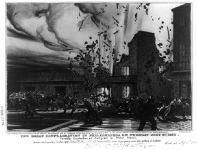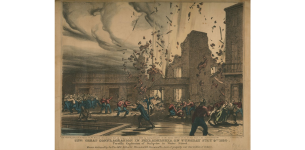Fire Service Line of Duty Deaths
July 9, 1850 - Philadelphia, PA. Major Fire kills 18 civilians, 10 Firefighters, destroys close to 400 buildings.

The first great fire in the history of Philadelphia began in the afternoon of July 9, 1850. Surely the city's most destructive conflagration during the 19th century, it started at a warehouse on the east side of Water Street, near the Vine Street Wharf on the Delaware River. The five-story structure between Vine and Race Streets (closer to Vine Street) was reportedly located at what then may have been numbered as 39 North Water Street and what is today approximately 237North Water Street. Known before the Revolutionary War as King Street, Water Street ran between Front Street and the wharves along the Delaware River—and later Delaware Avenue—for quite a distance. It passed through what was one of the most densely-populated places in the Philadelphia at the time. Philadelphia's 1793 yellow fever epidemic began and was concentrated only two blocks to the south along Water Street and the nearby docks.
The fire began when pressed hay stored in an upper floor of the warehouse somehow combusted. This did not cause much alarm, but several violent explosions of saltpeter—stored in the Water Street warehouse's basement—spread the fire. Burning hay and flaming embers from the destroyed building flew in all directions; the wind carried bits of smoldering sulfur (stored at an adjoining building) all the way to Broad Street. The hot dry weather of that July certainly did not help matters. Very quickly, the resulting inferno extended southwards to Race Street, westwards past Front Street to Second Street, and northwards to Callow hill Street. Many people who lived within half a mile of the district packed their things and prepared for a sudden evacuation. The entire city was at risk of a devastating catastrophe that night. Mass confusion prevailed. News of the blaze was telegraphed across the United States and was even later reported in England. (Other big news of that day was the death of President Zachary Taylor in office.)More than 100 firemen from as far away as Newark, New York, Wilmington and Baltimore arrived to relieve native firefighters who had became exhausted by the heat and their efforts. The inferno—its light seen for thirty miles around—was subdued sometime during the night. The calamity injured about 100 people and took at least 28 lives (accounts vary), including some killed in the street and in adjacent buildings as a result of the first great mighty explosion. Others were trampled in the chaos. Yet others drowned in the Delaware River from the shock of the main explosion or from purposefully jumping into the river to escape the devastation. Ten Firemen were also among the dead. Property damage was variously estimated at between one and 1.5 million dollars. Three hundred and sixty-seven buildings, including an old Quaker meeting house used as a school, were reduced to ashes in some 18 acres. About 300 of the destroyed structures were small rowhome dwellings, leaving many poor families homeless. In a fairly uncommon civic action in that era, the Philadelphia City Councils appropriated $10,000 for the relief of survivors, and the Commissioners of Northern Liberties did the same. Local citizens also contributed some$31,000 for the assistance of those injured. Almost all of Water Street as it existed in the 18th and 19th centuries has been obliterated by Interstate 95 and the Vine Street Expressway. But the part of Water Street between Race and Callowhill Streets still remains (as well as in South Philadelphia). The block that was ground zero of the explosion and fire was rebuilt and resumed being as congested as before. Some of the smaller buildings there were later replaced by larger warehouses. The area became very rundown and deserted by the mid-20th century. An empty lot now occupies the entire block, which is immediately north of the Philadelphia anchorage of the Benjamin Franklin Bridge. Plans for a condominium development at the site fell through, but it seems likely that the lot will one day be used for residential or recreational purposes, given its proximity to Penn's Landing and the entire Delaware River waterfront. The nearby block along Front Street (between Vine and Callow hill Streets) does contain residential housing and today comprises the core of the River's Edge Civic Association. All of these structures were built after 1850, some using the foundations of buildings destroyed in the colossal blaze. The basements of a few of these structures reputedly go back to an even earlier era in Philadelphia's history: the time when pioneers dug caves into the muddy embankment of the Delaware River as their initial shelter upon reaching the new settlement of Philadelphia in the 1680s. These shallow caves were later incorporated into some of the basements of the original houses and shops along what became Water Street.
The Firemen that died in the Line of Duty:
H. Lichtenhahm of the Assistance Engine Company
Richard Owens of the Assistance Engine Company
An Unknown Volunteer of the Assistance Engine Company
George McGinnis of the Hibernia Hose Company
David Mulford of the Northern Liberties Hose Company
Mr. Hoffman of the SpringGarden Hose Company
Mortimer Morris of the United States Engine Company
Thomas Stees of the Vigilant Fire Company
Isaac Brown of the Weccacoe Hose Company
An Unknown Volunteer

July 9, 1850 - Philadelphia, PA. Major Fire kills 18 civilians, 10 Firefighters, destroys close to 400 buildings.

The first great fire in the history of Philadelphia began in the afternoon of July 9, 1850. Surely the city's most destructive conflagration during the 19th century, it started at a warehouse on the east side of Water Street, near the Vine Street Wharf on the Delaware River. The five-story structure between Vine and Race Streets (closer to Vine Street) was reportedly located at what then may have been numbered as 39 North Water Street and what is today approximately 237North Water Street. Known before the Revolutionary War as King Street, Water Street ran between Front Street and the wharves along the Delaware River—and later Delaware Avenue—for quite a distance. It passed through what was one of the most densely-populated places in the Philadelphia at the time. Philadelphia's 1793 yellow fever epidemic began and was concentrated only two blocks to the south along Water Street and the nearby docks.
The fire began when pressed hay stored in an upper floor of the warehouse somehow combusted. This did not cause much alarm, but several violent explosions of saltpeter—stored in the Water Street warehouse's basement—spread the fire. Burning hay and flaming embers from the destroyed building flew in all directions; the wind carried bits of smoldering sulfur (stored at an adjoining building) all the way to Broad Street. The hot dry weather of that July certainly did not help matters. Very quickly, the resulting inferno extended southwards to Race Street, westwards past Front Street to Second Street, and northwards to Callow hill Street. Many people who lived within half a mile of the district packed their things and prepared for a sudden evacuation. The entire city was at risk of a devastating catastrophe that night. Mass confusion prevailed. News of the blaze was telegraphed across the United States and was even later reported in England. (Other big news of that day was the death of President Zachary Taylor in office.)More than 100 firemen from as far away as Newark, New York, Wilmington and Baltimore arrived to relieve native firefighters who had became exhausted by the heat and their efforts. The inferno—its light seen for thirty miles around—was subdued sometime during the night. The calamity injured about 100 people and took at least 28 lives (accounts vary), including some killed in the street and in adjacent buildings as a result of the first great mighty explosion. Others were trampled in the chaos. Yet others drowned in the Delaware River from the shock of the main explosion or from purposefully jumping into the river to escape the devastation. Ten Firemen were also among the dead. Property damage was variously estimated at between one and 1.5 million dollars. Three hundred and sixty-seven buildings, including an old Quaker meeting house used as a school, were reduced to ashes in some 18 acres. About 300 of the destroyed structures were small rowhome dwellings, leaving many poor families homeless. In a fairly uncommon civic action in that era, the Philadelphia City Councils appropriated $10,000 for the relief of survivors, and the Commissioners of Northern Liberties did the same. Local citizens also contributed some$31,000 for the assistance of those injured. Almost all of Water Street as it existed in the 18th and 19th centuries has been obliterated by Interstate 95 and the Vine Street Expressway. But the part of Water Street between Race and Callowhill Streets still remains (as well as in South Philadelphia). The block that was ground zero of the explosion and fire was rebuilt and resumed being as congested as before. Some of the smaller buildings there were later replaced by larger warehouses. The area became very rundown and deserted by the mid-20th century. An empty lot now occupies the entire block, which is immediately north of the Philadelphia anchorage of the Benjamin Franklin Bridge. Plans for a condominium development at the site fell through, but it seems likely that the lot will one day be used for residential or recreational purposes, given its proximity to Penn's Landing and the entire Delaware River waterfront. The nearby block along Front Street (between Vine and Callow hill Streets) does contain residential housing and today comprises the core of the River's Edge Civic Association. All of these structures were built after 1850, some using the foundations of buildings destroyed in the colossal blaze. The basements of a few of these structures reputedly go back to an even earlier era in Philadelphia's history: the time when pioneers dug caves into the muddy embankment of the Delaware River as their initial shelter upon reaching the new settlement of Philadelphia in the 1680s. These shallow caves were later incorporated into some of the basements of the original houses and shops along what became Water Street.
The Firemen that died in the Line of Duty:
H. Lichtenhahm of the Assistance Engine Company
Richard Owens of the Assistance Engine Company
An Unknown Volunteer of the Assistance Engine Company
George McGinnis of the Hibernia Hose Company
David Mulford of the Northern Liberties Hose Company
Mr. Hoffman of the SpringGarden Hose Company
Mortimer Morris of the United States Engine Company
Thomas Stees of the Vigilant Fire Company
Isaac Brown of the Weccacoe Hose Company
An Unknown Volunteer


